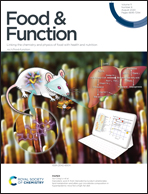Dietary citrus peel essential oil ameliorates hypercholesterolemia and hepatic steatosis by modulating lipid and cholesterol homeostasis
Abstract
Citrus peel essential oil (CPEO) contains abundant volatile compounds and exhibits fragrance properties and beneficial pharmacological effects on humans. Herein, we aimed to investigate the effects of CPEO on the prevention of hypercholesterolemia and hepatic steatosis in high-fat diet-fed rats and identify its possible regulatory mechanisms in lipid metabolism by combining lipidomics with gene expression analysis. CPEO at effective supplementation levels of 0.5% and 0.75% significantly ameliorated hypercholesterolemia and hepatic steatosis, including decreased serum total cholesterol (TC), low-density lipoprotein cholesterol (LDL-c), hepatic TC and triglyceride (TG) levels, and hepatic lipid droplet accumulation. Lipidomics analysis revealed that the total levels of fatty acid (FFA), TG and cholesteryl ester (CE) classes in the liver tissue were remarkably decreased after 0.75% CPEO supplementation some of which (3 TGs and 4 CEs) might emerge as potential lipid biomarkers in response to the effects of CPEO. Furthermore, these lipidomics findings were associated with downregulation of lipogenesis-related genes SREBP-1c, ACC and FAS and upregulation of bile acid biosynthesis-related genes LXRα, CYP7A1 and CYP27A1 in the liver. This study indicated that CPEO could effectively prevent hypercholesterolemia and hepatic steatosis, possibly because of its mediation of lipid and cholesterol homeostasis by altering liver lipid metabolites and regulating lipid metabolism-related genes.



 Please wait while we load your content...
Please wait while we load your content...